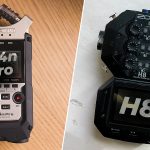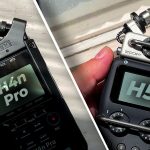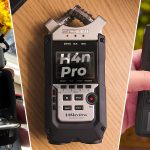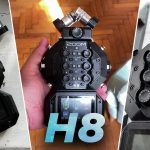In this review, we’ll compare two very popular Zoom recorders, the Zoom H5, and the Zoom H8. By the end of this, you’ll know what each recorder can do well, and what it’s not good at. You’ll also learn about a problem that both of these devices have, which most people aren’t talking about. Let’s go.

Inputs
To start off with, let’s see how many inputs each recorder has. The Zoom H5 has two XLR/TRS inputs, plus a 3.5mm input in the default X/Y capsule.
XLR/TRS means that it’s an input that can accept not just an XLR cable, which is what you’d use with a microphone, but also an instrument cable, like a guitar, or a bass cable.
The 3.5mm input is basically intended if you want to connect a lav, or radio mic to it. Bear in mind that, unlike the H4n Pro, which has the input built into the body, the H5’s input is part of its detachable capsule.
If you place a different capsule on it, it may or may not have a 3.5mm input.
More Inputs
In the case of the H8, you actually have 6 inputs, 4 x XLR inputs, and 2 x XLR/TRS inputs. So you can connect microphones to all six, but you can also connect four microphones and two instruments, or five microphones and one instrument.
You can do whichever combination you like, but bear in mind that only two of the inputs allow for guitar cables.
You also have the same issue with the 3.5mm input being part of the default X/Y capsule, and not part of the body.
Both of these devices can also deliver Phantom Power, if needed, to microphones that are connected to them. This isn’t the case with one of its capsules, but we’ll get into that a bit later.
Microphones
In terms of microphones, what you’ll connect to these devices depends on what you want to do. If you’re doing voice work, either as a podcast, or as a content creator, pretty much the best mic you can get is the Shure SM7B. It’s an absolute classic, it’s what every large podcast uses, and it’s also what I use now.
Actually, if you want to check out my complete audio recording setup, I have links down below where you can examine it in detail.
So, before we move on from inputs, how many do you actually need? If you just want a recorder that you can whip out of your bag, and record some sound effects, or ambiences, the answer is potentially zero.
Alternatively, if you do want to eventually experiment with external mics, especially if you want to plug a Rode NTG-2 into it, or similar, either of these devices can do that.
If you want to record instruments, live concerts, interviews, etc. it just depends on how many microphones you reasonably need.
For most people who podcast, if they know they’ll need more than two mics, the H8 is immediately the obvious choice. If you’re just making content by yourself, you’ll never need more than two inputs.
As a quick teaser, with the right hardware, the H8 can actually take more than six inputs, but we’ll talk about that later.
Battery Life
Next up, let’s talk battery life. If you’re going to take these recorders with you outside to record, which is what they’re mostly designed for, how much use will you get out of them before the battery goes flat?
According to Zoom, the H5 is rated for around 15 hours, and the H8 is rated for around 10 hours. Now, this can be rather optimistic, but how long you actually get will depend on a myriad of factors.
For example, neither of these devices has internal batteries. They both just take regular AA batteries, so the type and brand will make a difference. Also, are you just using the default X/Y capsule to record, or do you have multiple mics plugged in?
Are they using phantom power? Is the screen always on, and bright? All of these factors will affect things.
The moral of the story is that you should always have some spare AA batteries with you, just in case.
These types of devices also work with power banks, so that’s usually an option or, you can also purchase their accessory packs, which will include an adaptor and charging cable.
That way, you can have them connected to the mains, so you don’t have to worry about them turning off.
If you do want to check out those accessory packs, I’ve got affiliate links down below for each.
Affordability
What about price? While their prices can fluctuate, obviously the H8 is more expensive than the H5. These devices can cost different amounts, depending on what country you’re in, so I’ve actually included affiliate links down below, if you want to check out how much they actually cost in your country.
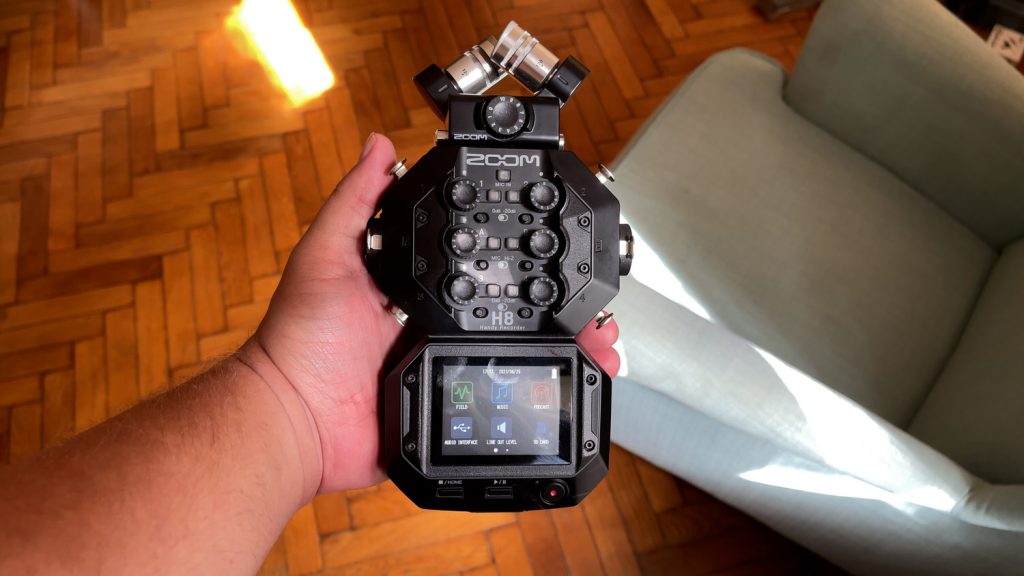
Display
When it comes to their screens, these two devices are indeed very different. The H5 has a backlit screen. It’s a pretty standard screen, nothing too impressive, but it does the job. You can see what you’re doing, and if you’re in a low-light environment, you can illuminate the screen, at the cost of a little bit of extra battery use.
On the other hand, the screen on the H8 is much nicer, and also touch-sensitive. This allows you to operate its apps and menus without the constant use of buttons and knobs.
Versatility
Next up, let’s talk about versatility. Just how versatile are these two devices, and in which scenarios are they useful to you.
So first off, the H5 obviously has fewer inputs. If you need to connect loads of stuff to your recorder, the H8 will be far more suited for that purpose.
Now, you can use the EXH-6 capsule, and extend that, but there are caveats when it comes to this capsule. We’ll talk about capsules a bit later on in this review.
Now, if you don’t need something with many inputs, the H5 takes up less space, and is also a lot more inconspicuous, compared to the H8, which will draw some attention.
Actually, since we’ve breached the topic of capsules, let’s talk about them.
Capsules
So, some of the Zoom H series devices can use these special capsules, which can be mounted on kind of like a lens on a camera.
Now, whenever I end up making a handheld recorder comparison, I’d always end up talking about the capsules in detail, and after doing that for multiple videos, I’ve decided that that’s not a very efficient use of either of our time.
As a result, I’ve made a short and to-the-point video for each capsule, and I put them all in a playlist on my YouTube channel.
In that playlist, I’ve also added some extra short videos that you might find useful. These short videos discuss whether you should be recording in mono or stereo, what sample rate to record at, which bit rate to record at, how to set your levels, so that you do not ruin your recordings, and more.
If you want to level up your production game, and learn about that stuff, I suggest you take a look at my playlist. Oftentimes, sound can be an intimidating topic, and people don’t know where to start.
This playlist right there is definitely a great place to get started.
If you don’t already know which capsules are available to you, I absolutely recommend watching the playlist after read this article, as some of the capsules, like the EXH-6, might actually surprise you.
Voice Overs
Now, a frequent use that these devices get is recording voice. How good are they for voice recording, and what can you do to mould them to your needs?
So, a while ago I was doing some travelling, and I needed a recording setup that was both effective, but also really portable. I needed something that would fit in this pocket that I have in my bag, so that I could just take it out, press record, and do my work.
I also needed something that wouldn’t sacrifice quality to any significant degree. Obviously what I was sacrificing was convenience.
Now I have my new setup, which is always ready to go. All I have to do is adjust the mic arm, and press record.
More Problems
Now, as if that wasn’t enough, I also had an extra problem to solve. You see, I could have just used the built-in X/Y mics that come with these recorders, but the problem is that they would have captured far too much of the room.
When booking an Airbnb, I couldn’t tell beforehand how noisy the place was, how much reverb I’d have to do with, whether the traffic outside would be bad at certain hours, etc.
I needed something that could address all these issues, and I came to the following decision. I brought with me a Zoom H6, with the Zoom SGH-6 capsule.
The reason, is that this capsule is very directional. It generally picks up on sounds coming from in front, while mostly ignoring sounds coming from the sides, or the back.
This is particularly useful if you just want to pick up your voice, but not your environment, which is almost always ideal.
This setup allowed me to record far cleaner audio in basically any environment.
Alternatives
By the way, the H5 and H8 would have also worked, but I like the feel of the H6 more, and it also fits better in the bag pocket, together with the SGH-6 capsule, so that was the deciding factor.
Again, playlist down below if you want to learn more about the kind of value that each capsule can bring into your life.
Audio Interface
Next up, can the Zoom H5 and H8 be used as an audio interface? Absolutely. Both of them can be used for that purpose.
The process is slightly different for each, but you just have to go in the Menu, and look for the option.
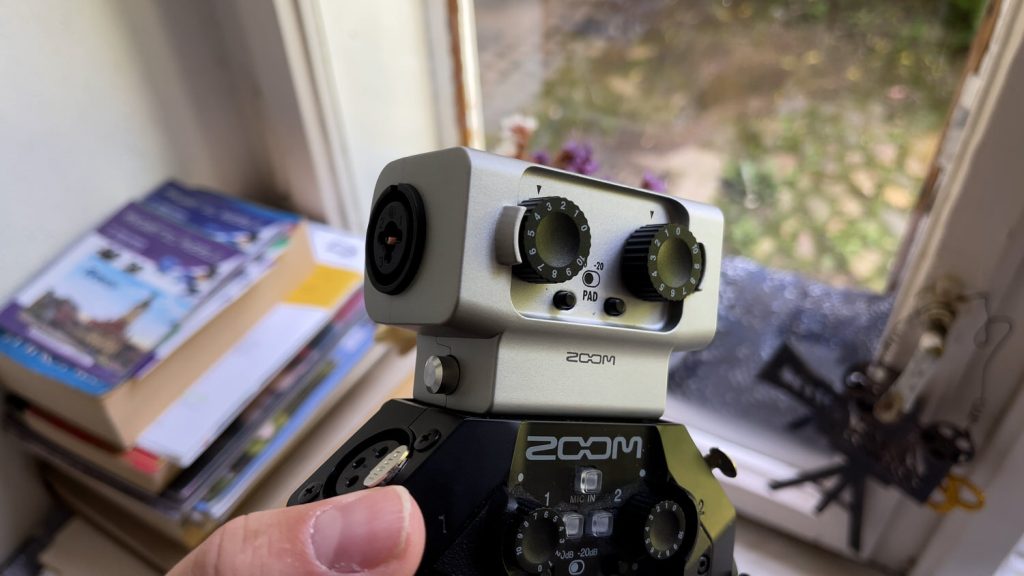
Free Sound Effects
By the way, did you know I have compiled the largest list of free sound effects in the world? Over 500GB of sounds, ready to be downloaded, free of charge. Just figured you’d want to know. And now, back to the review.
Sound Quality
Now, what about sound quality? Both recorders basically sound the same. They’re both suited for music, voice recording, concerts, instruments, sound effects, foley, and basically anything else you might need.
The H8 is of course far more versatile, due to its many inputs, but they’ll both produce the same quality audio.
Given that that is the case, what situations are these two devices not really good in?
That would be when recording super quiet stuff, like ASMR, or very quiet natural ambiences. The reason is simple. Every recording device, as a byproduct of its internal workings, produces a certain level of hiss.
This hiss is always present, in all recordings. The reason why it’s usually not noticeable is because the sounds that you do want are so loud, that they overpower the hiss.
If you record something super quiet, and then make it louder, you’ll also make the hiss louder. They’re on the same layer, so to speak.
Super Quiet
So, what can you do if you want to record really quiet stuff? Have a look at the Sony PCM-D100. Even though this recorder will also have some hiss, like all recording devices do, it has less than other handheld devices.
As a result, it’s far more suited for quiet recording.
The problem is that it’s currently kind of difficult to get a hold of, and very in demand, so the price has skyrocketed. I have an affiliate link down below, if you want to see how much it costs in your country.
Unfortunately, there aren’t any real alternatives to it out there.
Wind Protection
Up next, wind noise. So when recording outside, you’re going to have to deal with a fair bit of wind noise. Some recording devices do come with a foam windshield, which is unfortunately pretty useless.
So wind can be an issue when recording interviews, outdoor music performances, ambiences, that kind of stuff. What I normally use is this small kit from Rycote. It contains a windshield, a grip, and a shock mount.
The windshield deals with the wind, and then the grip and shock mount are used to eliminate handling noise, if you do choose to hold the device in your hand when recording.
It’s important to bear in mind that the windshield will have some limitations. Problems can occur with really strong wind, as any windshield has its limitations, but it will provide you with clean audio under reasonable weather.
Portability
Right, now let’s talk about portability. The obvious perk of a handheld recorder is that you can just throw it in a bag, and you can step outside, and record.
If portability is super important, I’d say the H5 is definitely more portable, as it is smaller, and generally more compact. It will also attract a lot less attention than the H8.
Guitar Effects
Now, a bit of a weird question, but since you can plug guitars into them, do they have built-in guitar effects?
The Zoom H8 does. This is personally not something that I use, but it is a feature.
Ease of use
How about ease of use? Can you easily use the H5, or the H8?
After having used both, I’d say the H8 would be a bit easier to use, because of the touch screen. Both the H5 and H8 have physical knobs, which you can use to adjust the gain, but the H5 is entirely operated with buttons and knobs.
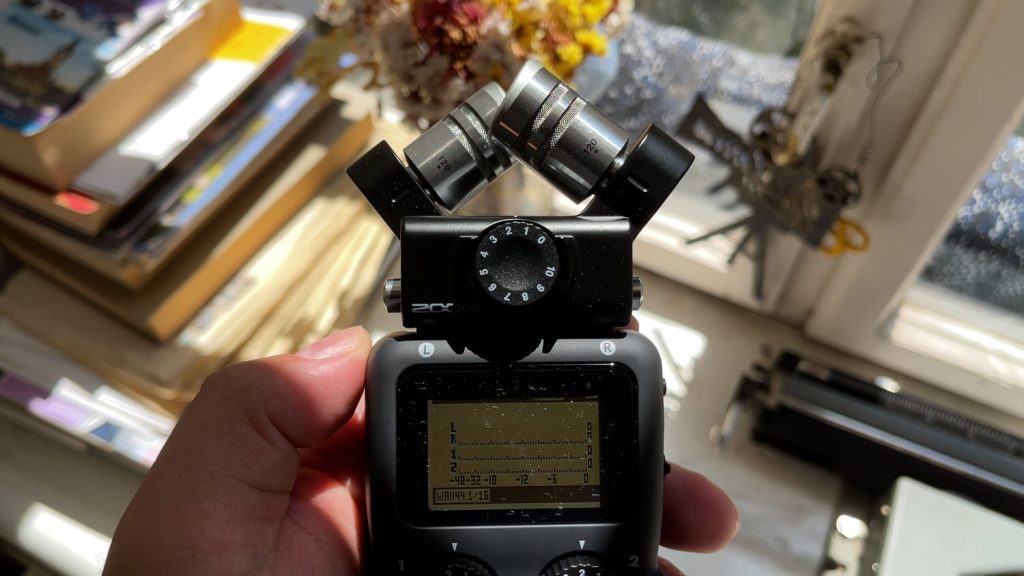
Size & Build
What about build quality? I’d say they’re equivalent. They’re definitely built differently, and they’re absolutely priced differently, but I wouldn’t say the H5 necessarily feels less premium, compared to the H8.
In terms of size, H5 measures around 197.3 x 66.8 x 42.16mm, or 7.77 x 2.63 x 1.66 inches, and weighs in at around 269 grams, or 9.52 oz. The H8 however measures 78.9 × 60.2 × 45.2mm, or 3.11 x 2.37 x 1.78 inches, and weighs in at around 354g, or 12.49oz.
So at the very start of the review, I mentioned a lesser-known issue with these recorders. After a few years of use, the rubberised coating that these devices use can become sticky to the touch.
This isn’t specifically an issue with Zoom recorders, but with devices with this kind of coating.
There are methods of removing the stickiness, but I’m not going to advise you on how to remove it, due to the risk of damage being done to the device.
Storage
Next up, storage. Neither of these devices have internal storage, but the H5 can take SD cards up to 32 GB, while the H8 can work with SD cards of up to 512 GB.
Even if you’re recording at 24bit/96kHz, a 32GB SD card will give you a lot of room to work with. If you record a stereo track at 24bit/48kHz, in theory, 32GB should allow you to record for 2000 minutes, which is equivalent to 33 hours.
Conclusion
In conclusion, which one should you purchase? Let’s have a look at each recorder.
So obviously the H5 is way more affordable, and more portable. You can just throw it in a small bag, head outside, and record. Alternatively, you also have the option of using almost as many capsules as the Zoom H8 can use. You are only limited to two inputs though, so there is that.
If that’s all you need, the Zoom H5 would be a fantastic choice.
However, if you want to use larger SD cards, you need more inputs, and you don’t care about the physical size of the device, the Zoom H8 would be a far better choice, especially if you want to do a podcast.
If the H5 is not enough, but the H8 is too much, I’ve actually reviewed other handheld recording devices on my YouTube channel.
Also, if you really want to level up, and quickly learn things that will help you improve your production quality, I would really recommend checking out that playlist I mentioned earlier.
If you’d like to purchase any of the items I’ve mentioned in this article, or see how much they cost in your country, I have a link down below where you can view them.
Thank you for reading my comparison review of the Zoom H5 vs H8. I hope you found this article to be enjoyable. I invite you to have a look at some of my other articles. We have something for everyone, whether you’re interested in audio, or cameras and lenses. Alternatively, if you prefer video reviews, feel free to have a look at my YouTube channel.
Product Links
Down below you will find all of the items I talked about in this article.
